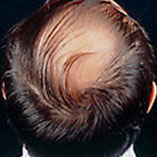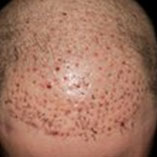What to expect
...after hair replacement surgery
The post-op development is influenced by carefuly following the instructions given by your doctor after surgery.
The first few nights sleep with your head elevated on pillows, in a semi-upright posture or using a neck pillow. If necessary, medication for sleep and pain is recommended.
At the base of each graft it will form a small scab, these scabs disappear in 4-14 days, nothing to worry about.
In the first week some soreness, tightness and possibly some numbness may apear in the donor area, and in the recipient area some swelling (forehead, or even face). This will receide normally after 7 days.
Shampooing can be resumed after 1-2-3 days from surgery (depending of your doctors instructions), very-very gently - NO touching, NO rubbing, NO scrubbing, best just pour a mix of water and shampoo, until the head is clean of any blood. In the first day of shampooing: wash like this 3 times per day. For the next 7 days, shampoo like this twice a day. Antibiotics may or may not be needed - follow your doctor advice, and a disinfectant lotion / shampoo may be prescribed to use during the first few days.
Avoid alcohol for a week after the hair replacement procedure and abstain from smoking for two weeks (to avoid circulatory problems).
Wear a hat if is to sunny, but NOT sunscreen (until at least 2 weeks after surgery).
Light exercise can be started in the first week, but avoid strong exercise for some weeks following hair restoration surgery, depending on your doctor instructions.
Avoid bathing, swimming, sauna, tanning for 2-3 weeks after the surgery.
The suture in the donor area will be completely healed after 7-10 days and the sutures (skin staples) can be removed - you will have an appointment at the clinic if this is the case. Some surgeons use absorbable stitches and these do not need to be removed .
Typically the grafted hair will shed in 2-4 weeks (do not worry, it's normal), but the root of these hairs remains intact and new hairs will grow from these roots between the second and the fifth month, at the normal rate of approximately 1/2 inch per month.
During the period in which the hairs will again begin to grow, some irritation of the skin may occur, which is caused by new hairs getting through the scalp. Also, the donor zone temporarily may becomes over-sensitive.
The final result can be assessed after 6 to 12 months.
Usually after 8-10 months the donor area has completelly recovered and, if another hair replacement procedure is needed , it can be considered.
| Time after surgery | Transplanted area | Donor area sutures (FUT / STRIP) |
Donor area (FUE) |
| First day after surgery | Begin to wash your hair gently - first 3 times /day, then only 2 times / day for the remainder of the week. The doctor may recommend a special disinfectant shampoo or lotion. | Some pain, tightness and numbness. | Tightness. |
| 2-3 days | Scabs largely disappeared. It can be seen more moderate redness. There may be swelling in the forehead. | Pains begin to disappear. Some numbness may still be felt. | Tightness. You can apply a cream or bio-oil to soothe the skin. |
| 1 Week | Redness is minimal or absent. Swelling usually begin to receide. First postoperative visit. |
The pain usually disappears. Numbness usually disappears. Occasionally it could still be swelling. | Tightness may persist sometimes. If it persists, you can continue to apply a soothing cream or bio-oil. |
| 2 Weeks | It looks and feels like a beard for 4 days. | Sutures begin to absorb. Discomfort disappears. Numbness is rarely felt. | The skin returns to normal. Rarely, redness can persist. |
| 2-8 Weeks | Hhair follicles enter the sleep phase (telogen phase) and the transplanted hair fall. This stage lasts about 3 months until restart anangena phase (during which hair grows about 0.5 inchs / 1 cm per month). | Nodes at the ends of absorbable sutures fall. | |
| 2-4 months | Some of the original hair (located in the receiving area) may fall. | Generally any residual numbness in the donor area disappear. | |
| 3-6 months | The transplanted hair begins to show, first as a very fine yarn. | ||
| 5-10 months | Part or all of the original hair that fell beginning to grow. | ||
| 8 months | Transplanted hair looks thin, but it continues to grow and thicken. Occasionally it can be observed a slight change in hair texture. | ||
| 8-12 month | The patient can be evaluated for further intervention, if needed. | ||
| 1 Year | 90% of hair transplant surgery show full results. | ||
| 1-2 years | There may be additional thickening. Any hair textural changes disappear and it returns to normal. | ||
Ask more!
Ask a medical representative a question about hair transplant:
Latest news
-

Transplant procedures can be somewhat painful mainly due to local anesthesia using injections into the scalp. But new procedures do not involve needles
-

Hair transplantation can be performed at any age, technicaly, but probably in many cases doctors recommend patients to wait up to an age close to 30 years.
-

-

Depending on the method used for harvesting grafts, recovery time can vary from a few days (FUE method) to 1-2 weeks (FUT or STRIP method)
-

Very important rules for a healty transition after hair transplant surgery.
-

What technique? FUE or STRIP? Advantages and disadvantages of each.
Latest forum posts
-


In the forums section you can receive informed answers (including from a medical representative) about hairtransplant issues, products or services of interest to you. Just ask!

